The job of the automotive industry is often to solve often difficult equations. And driving 7 comfortably in a passenger car (excluding minibus format and other vans, vans, minivans) is one of them. The thermal or hybrid offer is already relatively limited at this level in Europe, except for some machines from the Volkswagen, Toyota, Ford or Stellantis group. And in terms of electricity, in other words, we’re probably in the smallest market in the world.
The essential Tesla had its solution. Its large Model X SUV had the 7-seater option, essential especially in the American market where this offer is a kind of mandatory step for anyone who wants to sell cars with a truly family vocation. Unfortunately, the option is no longer available on the French market for this model. It is therefore necessary to turn to the more recent but smaller Model Y and both to say that, with its compact SUV coupe architecture, these last 2 places are really very symbolic and difficult to use.
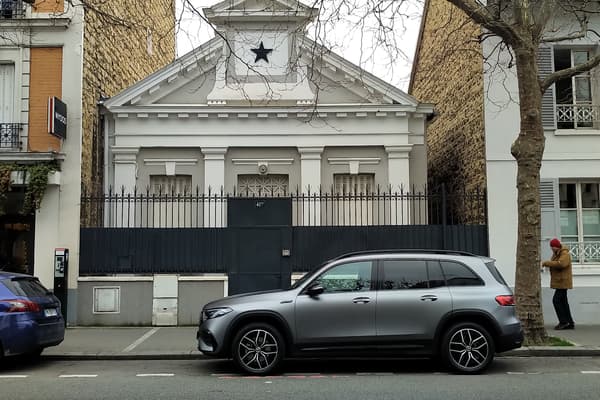
The highlight: a true electric family SUV
For this reason, Mercedes has decided to add an alternative to its electric range, an electric version of its GLB family SUV. Applying the successful recipe for converting the GLA to EQA, Mercedes has simply converted its GLB to electric, which becomes an EQB. The latter strictly uses the same platform and interior layout as the thermal version, without loss of space. And since the GLB is a 7-seater machine, they are also available in an electric version, thus offering the only alternative to Tesla at this level.
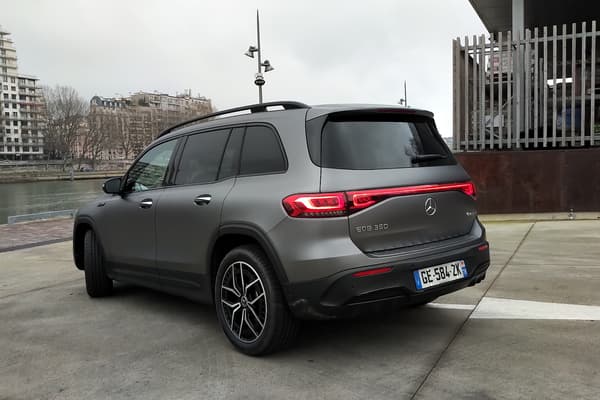
We find ourselves with a rather particular format, with a belt line not necessarily very high, but dominated by a raised cabin, which offers a lot of headroom and light with large glass surfaces, including a large sunroof. The whole gives a pure SUV, with very square shapes, which does not succumb to the coupé fashion to preserve all its practical aspects. We hardly noticed the typical grille of the electric EQ range of Mercedes, complete, lacquered and profiled for a little more aerodynamics. In the end, we have a machine that is somewhat reminiscent of the Volkswagen Tiguan, which remains a benchmark among family-oriented SUVs.
Very convincing practicality and modularity
And it is within the JCA that we realize it. Although this AMG Line version is treated with a sporty appearance (alcantara seat, glossy console with very careful materials, similar to that of the A-Class models, clear and non-intrusive digital instrumentation), the interior of the machine is marked by a worry. for practicality and modularity.
Wide enveloping seats for driver and passenger, wide rear bench (row 2), on flat ground, with a somewhat firm but comfortable seat, and above all adjustable in many ways: split in 3/3 individually or in its entirety, sliding forward- back with a fairly large free space, folding in two. All with a real attention to detail in terms of practicality, which means you will never lose your seat belts or their fixings between 2 seats, that you can rearrange everything and put it back in its place easily, safely and well thought out. A really satisfying detail, while this type of manipulation is sometimes difficult on other brands.
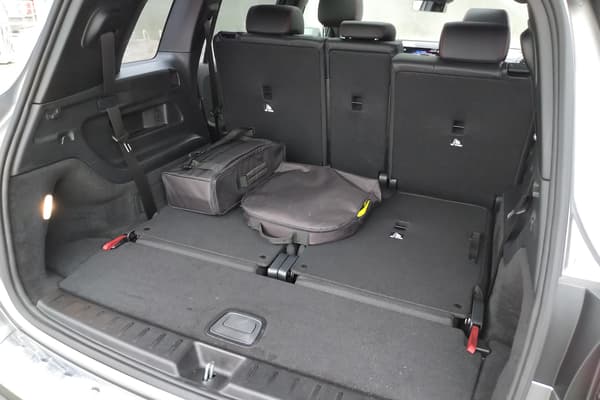
Finally, the boot is large with 495 liters and 1,710 once the seat in row 2 is folded down. A really convincing cargo area, and a set that combines the modular qualities of the best minivans of the 90s/2000s with an SUV architecture.
Really usable seats 6 and 7
And then there’s the bonus treat: the famous 2 rear seats. They form the boot floor and can be easily lifted. But above all, that they are accessible and at least comfortable. Of course, you must not exceed 1.75 meters, accept traveling with your knees slightly raised and see the trunk reduced to a simple glove compartment. But these 2 additional places are far from just additional puppets.
You can ride there serenely, admittedly a bit cramped in the trunk compartment, but without being folded in half. A small miracle made possible by the tall and square structure of the trunk. A real feat – keep in mind that getting out of it isn’t particularly easy anyway.
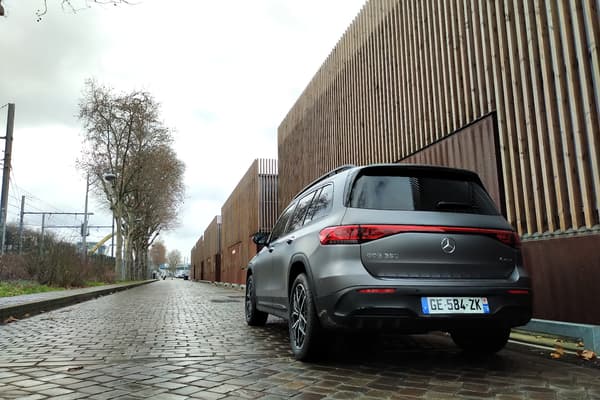
Give way to driving sensations. And from the outset, we are struck by a particularly remarkable ride comfort, undoubtedly superior to that of the compact EQA, and equaling that of the EQE sedan. A truly impressive magic carpet, coupled with exemplary operating silence, even at the level of rolling noise. Although it is heavy (2.17 tons), the EQB 350 moves with dynamism and rigor, as well as exceptional road holding.
In the bowels of the machine, a very capable powertrain, made up of 2 electric motors (one on each axis), a 70.5 kWh battery and all-wheel drive. Cumulative power is 292 horsepower, and if you engage sport mode, this big leggy cube manages to snatch 0-60 mph in 6.2 seconds. Very impressive but not very useful on these types of very flexibly damped machines, where we will particularly benefit from the whopping 520Nm of torque.
The black spot: a consumption that can skyrocket
Quite a nice looking machine, very well laid out, modular, roomy and capable. It seems like a no-fault, except when we start talking about consumption. With 409 kilometers of autonomy and even 480 in strictly urban driving, the EQB 350 is quite greedy in its use. Only a switch to strictly eco driving mode, air conditioning off, light footing, maximum energy regeneration and only on board or with a passenger guarantee you the opportunity to achieve this performance.
In this configuration, its average consumption will only be 17 or 18 kWh per 100 kilometers. But add the air conditioning, two more passengers, or adopt the “normal” or “sport” modes, and consumption will skyrocket, up to 30 or 40. And if you drive at 7 (one of the reasons for this model! ) and follow the highway, it goes without saying that its autonomy will be reduced by at least half.
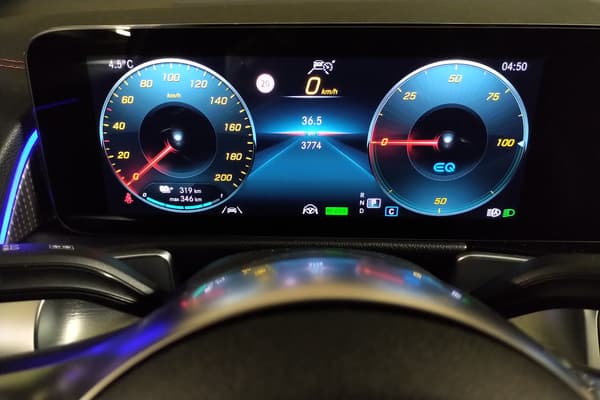
The EQB 350 makes up for it with relatively short recharging times for this type of machine: 17 hours on a simple 220v socket at 3.7kW, 8h30 with single-phase type 2 at 7.4kW (as in most public charging stations). of terminals), 5h30 with a 22kW three-phase type 2 charging station and between 30 and 40 minutes in a 100kW high power terminal of the Ionity type.
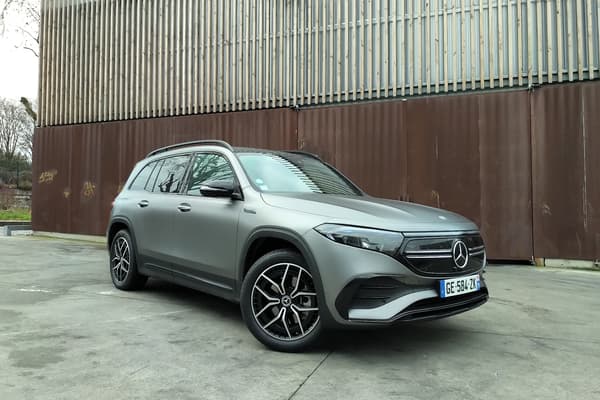
But at what price? A good deal
In addition, the EQB is a good value for money option for this type of vehicle, with a base price of 59,200 euros for the 250 single-engine version and 64,650 euros for the 350 twin-engine version. Rates year after year equivalent to those of Tesla And, the only alternative to fully electric driving at 7.
The Mercedes handily wins the challenge of comfort, perceived quality and modularity, not to mention its brand image. JCA will benefit from its status as Tesla’s sole competitor in this segment for a long time, with the competition, especially Volkswagen, taking their time.
There is a 7-seater ID6 SUV, for the moment only reserved for the Chinese market. But it is abundantly clear that this format collides with the laws of physics and will require some clever power management to prove that it is truly effective and practical.
Our test model: Mercedes EQB 350 4 Matic AMG Line
Price options included: 73,850 euros
Source: BFM TV

